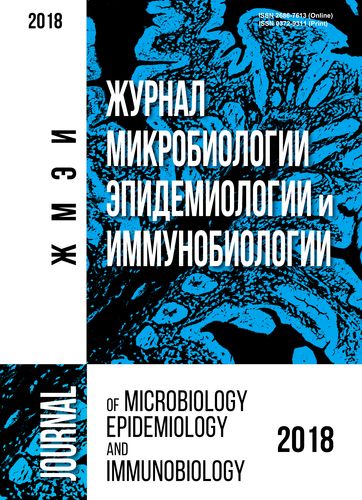АНАЛИЗ ЭФФЕКТИВНОСТИ РАЗЛИЧНЫХ МЕТОДИЧЕСКИХ ПОДХОДОВ, НАПРАВЛЕННЫХ НА ЭЛИМИНАЦИЮ ПЛАНКТОННЫХ КЛЕТОК И БИОПЛЕНОК ЛЕГИОНЕЛЛ В ПОТЕНЦИАЛЬНО ОПАСНЫХ ВОДНЫХ СИСТЕМАХ
- Авторы: Тартаковский И.С.1, Груздева О.А.2, Карпова Т.И.1, Дронина Ю.Е.1, Тарасова Т.А.1, Логинова О.Г.1, Дмитриева М.Н.1
-
Учреждения:
- Национальный исследовательский центр эпидемиологии и микробиологии им. Н.Ф.Гамалеи
- Первый московский государственный медицинский университет им.И.М.Сеченова
- Выпуск: Том 95, № 4 (2018)
- Страницы: 119-124
- Раздел: МЕДИКО-БИОЛОГИЧЕСКИЕ АСПЕКТЫ ПРИРОДНЫХ СИМБИОЗОВ
- URL: https://microbiol.crie.ru/jour/article/view/297
- DOI: https://doi.org/10.36233/0372-9311-2018-4-119-124
- ID: 297
Цитировать
Полный текст
Аннотация
Ключевые слова
Об авторах
И. С. Тартаковский
Национальный исследовательский центр эпидемиологии и микробиологии им. Н.Ф.Гамалеи
Автор, ответственный за переписку.
Email: noemail@neicon.ru
Россия
О. А. Груздева
Первый московский государственный медицинский университет им.И.М.Сеченова
Email: noemail@neicon.ru
Россия
Т. И. Карпова
Национальный исследовательский центр эпидемиологии и микробиологии им. Н.Ф.Гамалеи
Email: noemail@neicon.ru
Россия
Ю. Е. Дронина
Национальный исследовательский центр эпидемиологии и микробиологии им. Н.Ф.Гамалеи
Email: noemail@neicon.ru
Россия
Т. А. Тарасова
Национальный исследовательский центр эпидемиологии и микробиологии им. Н.Ф.Гамалеи
Email: noemail@neicon.ru
Россия
О. Г. Логинова
Национальный исследовательский центр эпидемиологии и микробиологии им. Н.Ф.Гамалеи
Email: noemail@neicon.ru
Россия
М. Н. Дмитриева
Национальный исследовательский центр эпидемиологии и микробиологии им. Н.Ф.Гамалеи
Email: noemail@neicon.ru
Россия
Список литературы
- Груздева О.А. Научно-методические основы профилактики легионеллеза в гостиничных комплексах. Эпидемиология и вакцинопрофилактика. 2014, 2:49-53.
- Груздева О.А. Научно-методические основы обеспечения профилактики легионеллеза в условиях мегаполиса. Автореф. дисс. д-ра мед. наук. М., 2017
- Карпова Т.И., Дронина Ю.Е., Алексеева Н.В. и др. Формирование биопленок Legionella spp. в эксперименте. Журн.микробиол. 2008, 1:3-7.
- МУК 4.2.2217- 07 «Выявление бактерий Legionella pneumophila в объектах окружающей среды», 2007.
- Садретдинова О.В., Груздева О.А., Карпова Т.И. и др. Контаминация Legionella pneumophila систем горячего водоснабжения зданий общественного назначения, в том числе лечебно-профилактических учреждений. Клин. микробиол. антимикроб. химиотер. 2011, 2:163-167.
- Самсонова С.П., Сергиенко А.И., Шалимова Е.В. и др. Очистка воды от микробиологических загрязнений и биопленок в оборотных системах различного назначения. Водоснабжение и санитарная техника. 2017, 6:22-27
- Санитарные Правила 3.1.2.2626-10 «Профилактика легионеллеза», 2010.
- Тартаковский И.С., Демина Ю.В. Методология и стандарты профилактики легионеллеза. Жизнь без опасности. 2010, 4:108-120.
- Тартаковский И.С., Груздева О.А., Галстян Г.М., Карпова Т.И. Профилактика, диагностика и лечение легионеллеза. М., 2013.
- Тартаковский И.С., Карпова Т.И., Груздева О.А. и др. Влияние температуры на жизнеспособность планктонных клеток и модельных биопленок Legionella pneumophila в воде. Журн. микробиол. 2015, 5: 7-11.
- Barbaree J.M., Gorman G., Martin W.T. et. al. Protocol for sampling environmental sites for legionellae. Appl. and Environ. Microbiol. 1987, 53(7):1454-1458.
- Cooper A., Barnes H.R., Myers E.R. Assessing risk of Legionella. Ashrae J. 2004, 46(4): 22-26.
- Declerck I.P. Biofllms: the environmental playground of Legionella pneumophila. Environ. Microbiol. 2010, 12(3):557-566.
- Fields B.S., Benson R.F., Besser R.E. Legionella and Legionnaires Disease: 25 years of investigation. Clin. Microb. Rev. 2002, 15(3):506-526.
- Legionella and prevention of Legionellosis. Ed. J.Bartram. WHO, 2007.
- Mampel J., Sprig T., Weber S.S. Planctonic replication is essential for biofilm formation by Legionella pneumophila in a complex medium under static and dynamic flow conditions. Appl. Environ. Microbiol. 2006,72(4):2885-2895.
Дополнительные файлы






